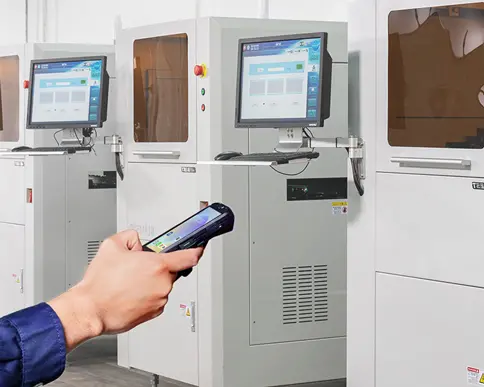Brief Introduction
As a professional mobile device, mobile computers play a crucial role in industries such as logistics, healthcare, manufacturing, and retail, thanks to their integrated computing and communication capabilities. Their efficient and user-friendly operation provides intelligent support for workflow optimization. Today, we will provide a detailed guide on operating mobile computers and explore their practical applications across various fields.

Ⅰ Basic Components of Mobile Computers
Mobile computers typically consists of the following components:
1. Hardware – Includes a touchscreen, physical buttons, camera, barcode scanner, NFC module, and more. These features enhance the device's flexibility and functionality.
2. Operating System – Mobile computers operating systems include Android and Windows CE, offering user-friendly interfaces and a wide range of applications.
3. Battery – Since mobile computers are frequently used on the go, battery life is critical. High-performance batteries ensure uninterrupted operation during extended use.
4. Wireless Communication Module – Includes Wi-Fi, Bluetooth, and mobile data, enabling seamless network connectivity for real-time data synchronization and transmission.
Ⅱ Initial Setup and Configuration
After acquiring mobile computers, follow these basic setup steps:
1. Power-On Setup – Press the power button to turn on the device, then follow on-screen prompts to configure language, time, and network settings.
2. Application Installation – Download necessary apps based on work requirements. Mobile computers support direct downloads from app stores or installation via a connected computer.
3. Device Pairing & Connectivity – Connect to peripherals such as printers or scanners via Bluetooth or Wi-Fi to ensure smooth data transfer.
4. Security Settings – Set up passwords, fingerprint recognition, or other security measures to protect sensitive data.
Ⅲ Daily Operation Tips
Mastering daily mobile computers operations is essential for improving efficiency. Here are some key techniques:
1. Touchscreen Operations – Learn basic gestures such as swiping, tapping, and long-pressing to quickly switch apps or return to the home screen.
2. Data Entry – Use the on-screen keyboard or an external keyboard for input. Mobile computers also support voice input and handwriting recognition for faster data entry.
3. Barcode Scanning – Utilize the built-in barcode scanner to quickly capture product information. Simply align the scanner with the barcode, and the device will automatically recognize and display the data.
4. Data Synchronization – Regularly sync device data with cloud storage for secure backup. Mobile computers also support offline operation, storing data locally before uploading later.
Founded in 2002, SEUIC Technologies Co., Ltd. has been committed to grasping core technologies, enhancing technological innovation, providing excellent self-owned brand products, including mobile computers, RFID readers, tablets, barcode scanners and fixed readers. With highly reliable products and efficient services, our products have been widely used in manufacturing, retail, logistics & transportation, healthcare and other industries. We provide frontline workers more durable real-time data collection tools, helping you do more thereby to catapult your productivity to the next level.- The Critical Role of Mobile Computers in Warehouse Logistics2025-06-25
- Seuic Mobile Computers: Multi-Scenario Efficiency Solutions2025-06-24
- Operation Guide and Industry Applications of Seuic Mobile Computers2025-06-23
- How to Choose Mobile Computers for Your Industry Needs2025-06-20
- Mobile Computers: The All-in-One Tool from Data Collection to Industry Implementation2025-06-19